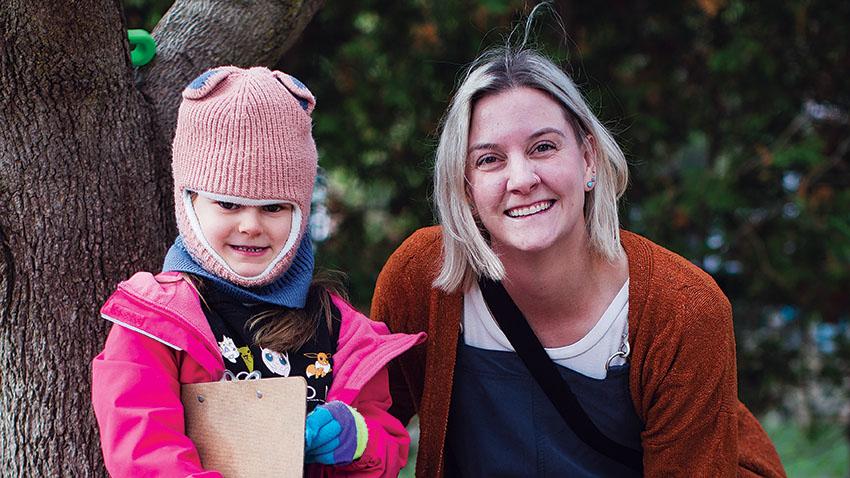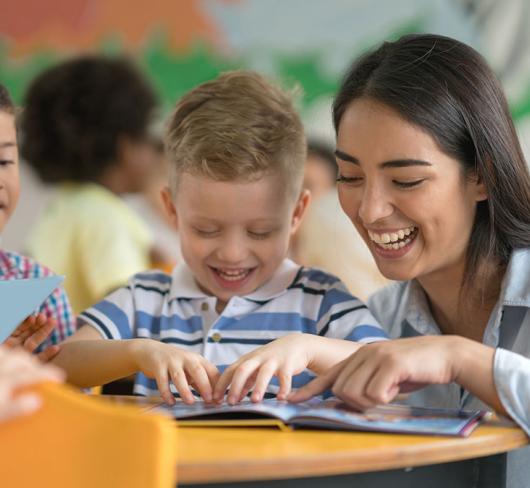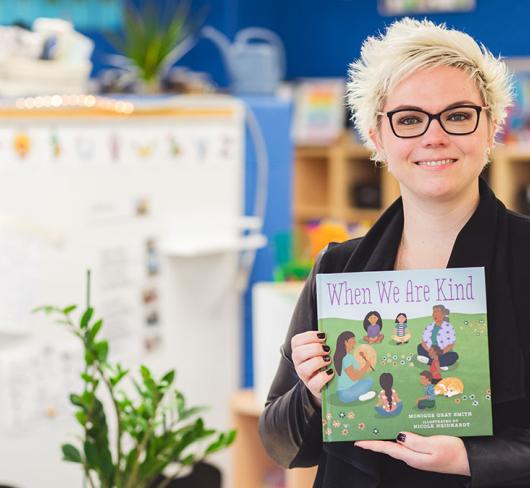
Gentle Teaching
Picture this: you have a lively class of students and it’s time to get ready to go outside. It’s winter and you know what that means … snow pants. You have a student crying because their mittens “don’t fit right,” a student who has been ready for five minutes and is now climbing on top of other students’ bodies, and a student who has just informed you that they peed in their snow pants and boots. Are you feeling overwhelmed?
Teaching has not become easier post-pandemic, for any grade. As educators in public schools, we are no strangers to incident reports, evacuations and behaviour plans. Many students seem to have little tolerance for frustration. The smallest perceived problem can unsettle them. If you feel like much of your time is spent putting out metaphorical fires, you are not alone.
In working with seasoned and new educators, we’ve discovered that the traditional compliance-based approach to teaching only escalates the behaviours we see in our classrooms. The “I am the adult, and you will listen to me” approach may send students into a fight, flight or freeze response, none of which are conducive to learning. So, what do we do?
Transitioning to Gentle Teaching
We have spent the last few years moving towards a “gentle” or responsive model of teaching. This responsive approach allows us to build connections with students and address the specific skills they need to learn in order to regulate their behaviour. After all, self-regulation is a learned skill. Our goal is to model and foster these skills for our students, so they are able to function in a classroom environment. A dysregulated student is generally not able to learn or participate in classroom activities. With that in mind, self-regulation is the foundation for everything we do in the classroom.
The phrase “gentle teaching” may make you feel uneasy. Perhaps you’re envisioning a permissive environment where the students are left to do whatever they like.
Let’s play a bit of True or False and dispel some of those beliefs.
We Don't Say No to Our Students
False. Absolutely false. Students need to hear no, and we are firm believers in setting high expectations for our class. We hold boundaries with our students. We don’t let them do whatever they want but we do leave space for them to have feelings about our boundaries. “I know that’s not the answer you were hoping for, and you can be upset, but my answer is not going to change.”
We Never Lose Our Calm During the Day
False. We are human. Of course there are moments as educators when we experience frustration. But we prioritize managing our emotions and reactions, responding thoughtfully rather than impulsively. It’s important that we show our students that we also experience the full range of human emotions. Talking to our students about our feelings or asking them for strategies on how we can bring ourselves back to calm gives them a chance to showcase what they have learned about calming themselves.
Gentle teaching is not permissive teaching. It’s about being gentle with our students and with ourselves as we manage moments of excitement, frustration and growth.
The "Reframes" That Changed Our Perspective on Student Behaviour
Our approach to teaching young learners is based around a few core beliefs that we feel to be true about children.
The first is one we learned from clinical psychologist Ross Greene, who built a model of care for children exhibiting challenging behaviours (called Collaborative and Proactive Solutions) based on the theory that “children do well if they can.” This principle helps us as educators reframe child behaviours, especially challenging ones, and see children through a lens of compassion rather than frustration. Yes, it may sometimes feel like students are choosing behaviour that will intentionally frustrate us. But we have learned to look deeper at what boundaries may be preventing them from being successful. Are they hungry? Tired? Managing stressful situations at home? There are many reasons it may be difficult for a child to access skills we know they have or to learn new ones.
The second is acknowledging that behaviour is communication. When a child is struggling, we look at them with curious eyes and ask ourselves questions like, “What do we know about this child?” and, “What is this child trying to tell us?” These questions help educators brainstorm as they begin to problem solve and develop a plan to support a child who is struggling. They also help us remember that children are still learning and it’s our job as adults to approach them with open hearts and open minds.
The final pillar of our approach stems from an oft-quoted line from Kids These Days by Jody Carrington, a Canadian psychologist who specializes in trauma integration: “Every time you hear yourself say, that kid is ‘attention seeking,’ replace it with that kid is ‘connection seeking,’ and watch your perspective change.”
The first time we heard this, it rocked our worlds because of how many times as new educators we heard the phrase “ignore them, they’re just looking for attention.” For us, that never felt like a solution because it didn’t feel like it addressed the problem. And while, yes, sometimes there are behaviours that we don’t want to reinforce or acknowledge, it never felt right to ignore the child altogether. If we believe that behaviour is communication, we can recognize that while the behaviour a child is exhibiting can be frustrating or disruptive, it is also how the child is desperately trying to communicate a need that they don’t know how to articulate any other way.
Each of these three pillars guide our practices when we are working with all kids but are particularly important when we are supporting students with challenging behaviour. When we work with these students, we try to first approach them with curiosity: What do we know about this child? What was their morning like? Do they struggle at a particular time of day? What are the triggers that present a unique challenge for this student?
Next, we work to identify the skills that the child is missing or that are lagging. Is the child who is hitting others doing it because they are angry all the time? Or are they trying to enter play but lack the communication skills to do so appropriately? Are they over stimulated and need a gross motor activity or outlet to help get out any pent-up energy? What questions do we need answers to in order to help us identify the lagging skills?
Once we have identified the key lagging skills, we can begin to teach the skill and prioritize that child’s learning in a particular area. Keeping these ideas in mind also helps us regulate ourselves and maintain our calm when a child’s behaviour is hard and frustrating for us to manage.
Practical Phrases We Use with Our Students
The language we use holds tremendous power, not only for those who hear the words we use, but for ourselves. Using the following phrases has helped us reframe behaviour, get curious about our students and feel more connected. We have seen students adopt these phrases in their own turn and use them with their peers. We invite you to pick one, or try all three, and see how they change student responses and your own reactions to challenging behaviour or situations.
Pause
The beauty of “pause” is its simplicity. Pause has effectively replaced “stop” in our classrooms. Why? We have found that if we are constantly saying stop, it becomes easy to ignore. We reserve STOP! for matters of safety and urgency, and it is heard. We’ve encountered a number of students whose behaviours escalate when they are told to stop. Instead, we might say “Woah, everyone, pause. Let’s take a big breath and come up with a solution together.”
Have a crowd of students all trying to get your attention at once?
“Pause!”
See students building with blocks a little too high?
“Pause. Have you thought about…?”
Pause does not mean full stop, period, done. It means we will continue after taking a moment to regroup or reassess together. We love hearing our students ask each other to pause so they can re-examine the rules of a game or ask a peer a question.
Thanks for Letting Me Know
Students love structure. They crave rules and boundaries. Not surprisingly, once they know the rules, they frequently feel the need to tell you when one is being broken. “Tattling” is the word most would use to describe this behaviour. We’ve seen a lot of different strategies for teaching students the difference between tattling and telling. What we’ve found is that no one approach can ensure students are successfully sharing information that needs to be shared, and we would rather have our students come to us with everything than chance us missing something important.
This is where the phrase “thanks for letting me know” comes in. Any time a student tells us something, whether it’s important and requires a follow up or not, we thank them for letting us know. Often this phrase is all they need. Why? It helps them feel safe, seen and heard. Safe, because they know we will uphold the rules, and rules make their environment safe and predictable. Seen and heard because we are giving them the brief moment of connection they are asking for by coming to us in the first place.
“I’m getting picked up early today.”
Thanks for letting me know.
“I saw them push someone at recess.”
Thanks for letting me know.
“I miss my family.”
Thanks for letting me know.
What's Your Plan?
Do you ever see a student doing something odd and assume they are misbehaving? Us too. This phrase has helped us get curious, not furious, in those moments. Asking “What’s your plan?” has replaced “What are you doing?” which can be perceived as accusatory. Now, when we see a student walking with a stick in hand, we ask “What’s your plan?” and are usually provided with surprising insight into what a child is thinking.
If there is no plan, this phrase presents an opportunity to come up with one together or to offer considerations. “I’m wondering if you’ve thought about how to keep everyone safe while holding that stick?” We love that asking for a plan gives students a chance to connect with us and practice communicating their thinking. It also opens the door to getting information you may have missed, since despite what our students may believe, we don’t have eyes in the backs of our heads and can’t see everything all the time!
Be Gentle with Yourself, Too
This piece can be hard, but it is also incredibly important. We are educators, charged with the learning and development of our students, but we are also humans. A big part of this gentle approach that we have worked to develop for our students also needs to be extended to ourselves. When we have worked so hard to be patient but are experiencing patience fatigue, when we have tried every trick and tool that we have and they haven’t worked, when we have things going on in our lives outside of school and it feels too heavy, we need kindness and gentleness, too. So next time you’re feeling frustrated with yourself, we hope that you can take just a moment to breathe and say, “This is hard. I am doing the best I can,” and be gentle with yourself.
Alannah McGregor and Avery Gray are members of the Upper Grand Teacher Local.

